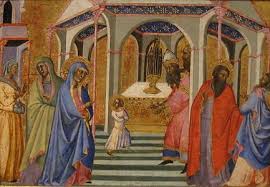The Presentation of Mary – commemorating Our Lady’s dedication and consecration to God as a young girl of about three years old in the Temple – is found in none of the four traditional Gospels, but rather related in the apocryphal ‘Gospel of James’, which dates from the beginning of the third century. However, as Paul VI puts it in his 1967 Apostolic Exhortation Marialis Cultus, that “apart from their apocryphal content present lofty and exemplary values and carry on venerable traditions having their origin especially in the East”. That is, they can teach us much, even if not everything therein has the hallmark of truth.
As such tradition goes, Mary’s parents, Joachim and Anna – whose names are also apocryphal, but traditional – were elderly and childless, but, faithful and devout. They trusted in God that someday He would fulfil His promises and send them progeny, a recurrent theme in Scripture. Sure enough, He did, far more than they expected, for the child they conceived was immaculate, ‘without original sin’ – literally, ‘without stain’. And Mary, the child, was to remain not just sinless her whole life long, but ‘full of grace’, the greatest creature in all of God’s creation, fitting for the one who would later also conceive immaculately the Redeemer Himself. One does have to marvel.
The public celebration of the feast dates back to 543, with the building of the basilica of ‘Saint Mary the New’, in the reign of Justinian I, near the site of the Temple of Jerusalem where the soon-to-be Mother of God was raised. Perhaps they had in mind that this is also the Jewish feast of Hanukah, commemorating the re-dedication of that same Temple by Judas Maccabeus in 164 B.C. Our Lady is, after all, the new Temple, and the re-dedicatio ultima, if we may put it so.
Our present feast went through various permutations, at first suppressed after the Council of Trent by Saint Pius V in 1568 – who may have had some misgivings about its origin in the apocrypha – but soon reintroduced by Clement VIII in 1597, who elevated the Presentation to a greater-double feast. It was kept in the revisions of 1969 as a memorial, but still has that echo of a feast, looking forward to the great celebration of her Son’s birthday.
This day has a special significance for those in religious and consecrated life, those who have given ‘all’ to serve Christ and His salvific work. For giving up some of the most significant natural pleasures of this life – those of marriage and family life, and one’s own property – leaves one more free to practice charity in a more perfect manner, at least in an objective, apostolic sense. Karol Wojtyla would not have been ‘John Paul II’ if he had married and settled down as a virtuous professor at Jagiellonian. We are all grateful he chose the higher path he did, as we are for Our Lady as well. They were given much, and they gave much.
There is a tradition that Our Lady made a vow of virginity as a young girl, which would have been quite out of the ordinary, as every Jewish maiden hoped to be chosen as the mother of the Messiah. In one of those many paradoxes in the Christian dispensation, the maiden God ended up choosing is the very one who gave all, even to the point of giving up any natural hope of being ‘the one’. How can this be, since I do not know man? But as the angel replied that, with God, all things are possible.
In a unique and singular way, Our Lady fulfilled those promises her Son later offered: He who loses his life for my sake will find it, the first shall be last, and the last first, that God has indeed looked upon His lowly handmaid, and that all generations will indeed call her blessed, right up to the end of time, for He Who is holy has done great things.
By that gift of her very self, not only holy is His name, but the name of His mother as well.
Holy Mary, ora pro nobis.

